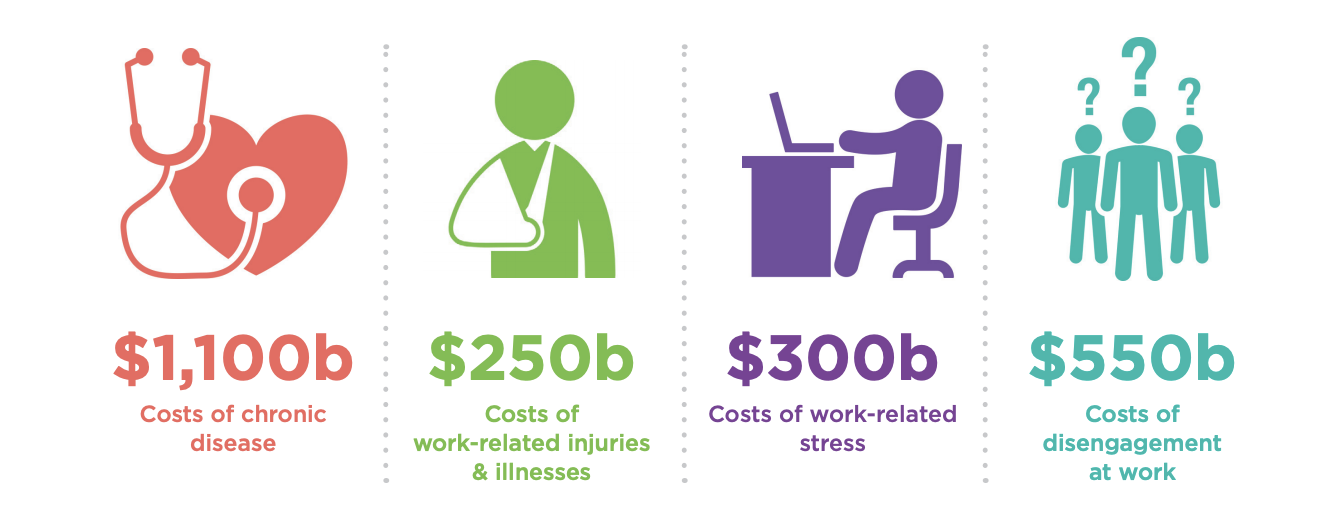Recently, The Global Wellness Institute (GWI) released its Future Of Wellness At Work research report. The 82 page report, which can be downloaded for free, examines the current state of wellness in the global workforce and predicts what the future of work will look like. The report makes the case for why wellness will matter more in the future and presents a new vision for wellness at work. Despite its length, the report is worth reading. Until you find time to get through the whole thing, below are our top 5 interesting facts that came from the report. Enjoy!
#1 – Unwellness Is Expensive
“Unwellness” at work costs the U.S. economy $2.2 trillion annually, or 12% of GDP. Disengaged workers cost businesses $550 billion in lost productivity while workers with chronic disease cost companies $1.1 billion. The rest of the tab stems from $250 billion in work-related injuries and illnesses, and $300 billion in work-related stress. Many people can and should question the amounts in their estimates (chronic conditions may be high depending on what they define as “chronic condition”), but nonetheless, the costs to employers and economy are too high to ignore.

#2 – 31% Of U.S. Workers Participate In Employee Wellness Program
This number is embarrassing for programs that are supposedly designed for employees, but it isn’t that surprising (Gallup reported 24% participation). The detailed explanation for this dismal participation has to be left for a separate post, but the short answer is that most wellness programs do not have the employee in mind. If they did, biometric screenings and health risk assessments would not be so prevalent. What may be even worse is that most wellness vendors, despite being fully aware of their own participation and engagement results, still believe in a per eligible per month pricing model.
#3 – Employees Recognize The Impact Of Wellness On Their Work
U.S. workers reported that when they feel physically or mentally unwell, it affects many aspects of their work performance, including their ability to get work done (62%), their engagement in work (63%), and their motivation to do the job well (62%). These numbers underestimate the impact of wellness on productivity by not even reflecting those employees who do not recognize the impact their well-being is having on their work.
#4 – Work Environments Matter
Work can create mental and emotional distress, including financial challenges of low wages, long working hours and the inability to unplug, work-life balance issues, or difficult relationships with bosses and coworkers. These stressors can lead to physical illness. Respondents to a GWI survey said that when their job or workplace environment causes them to feel unwell, many other aspects of their lives are also affected, including mental/emotional health (69%), physical health (50%), family life (3%), relationships (35%), and overall happiness (66%). Work is too big a part of one’s life for it not to have a large impact on personal well-being. The reach of that impact cannot be understated.
#5 – “Caring Companies” Boost Worker Health And Productivity, Not Wellness Programs
So we lied…this information is actually in another GWI report, but it was too good to pass up. “57% of employees at caring companies rate their health/wellness high (4 or 5 stars), vs. only 39% of those at non-caring companies. Conversely, only 8% of those at caring companies report poor health, vs. 21% at non-caring companies…Only 17% of workers at caring companies report “very high” levels of stress, vs. 41% at non-caring companies. And workers at caring companies are dramatically more engaged: more than twice as likely to report that their work is satisfying (52% vs. 25%), exciting (33% vs. 16%) and interesting (66% vs. 30%). Workers at caring companies (68%) are also radically more likely to report that “they’re proud to be associated with their company” than those at non-caring organizations (19%).”

All though the presence of a workplace wellness program has almost no impact on overall health/wellness, caring companies are more likely than the non-caring (67% vs. 41%) to provide employees with a formal wellness program and more likely to encourage healthy behaviors overall. It goes without saying that employers who care about their employees are more willing to invest in their health, which includes offering effective wellness solutions and ignoring the harmful ones (biometric screenings, HRAs, weight loss challenges, etc.). Caring companies are far more likely to go beyond the basics of health insurance and offer more tangible, proactive wellness benefits, such as exercise support, flexible work arrangements, stress reduction programs and even opportunities to have fun at the office, whether with a ping pong table or fitness challenges.
Note: The facts and figures above highlight some points that we felt were interesting and generally a fair characterization of the state of employee wellness. This post is not an endorsement of the GWI report and not be seen as validation for the statistics in the report but not found in this post.












